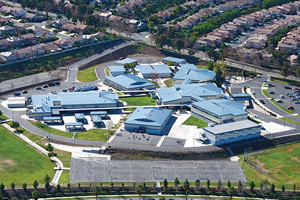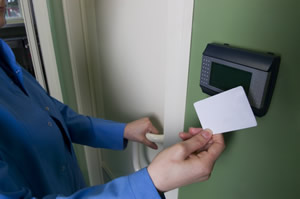All Round School Security
- By Michael Fickes
- 11/01/17

PHOTO © CHAD MCDERMOTT
In the United States, there are more than 130,000 public and private schools serving more than 50 million students daily. How safe are the students, faculties and administrators who use these schools every day during the school year?
Recent acts of violence have led school administrators and security professionals to re-evaluate the security protections provided in their schools. Is this school’s security good enough for the nature of the school’s environment and also for the general risks of today’s uncertain world?
“I have always been a firm believer that school administrators need to do everything possible to maintain a safe and secured campus,” says Patrick V. Fiel, Sr., a security consultant and nationally known expert with more than 35 years of experience managing law enforcement and security organizations. Fiel founded and manages PVF Security Consulting.
Does securing a school and campus mean locking it down completely? In many cases, yes. For any particular school, the answer probably depends on the school’s location and the hazards in the neighborhood surrounding the school.
Encircling a Campus and a School with Security
According to Fiel, securing a school building and its grounds begins by drawing three circles on a map of the community and the school.
“Draw a circle around the school at a one mile radius of the building,” Field says. “This is the school’s community. What happens in this community can affect school security.
“Next, draw a circle around the boundaries of the campus, taking in the school and any outbuildings as well as parking lots and sports fields. These areas, of course, all lie within the school’s responsibility.
“Finally, draw a circle around the building itself.
“In developing a school security plan, I look at these three circles — or perimeters — and think about what could affect school security along each circle.”
What can school security people can do about problems that might exist between the one-mile circumference inward to the school grounds? Not a thing. That is a community policing task. Still, it’s important to know what problems exist there because those problems will affect the security plan for the perimeter of the grounds and the perimeter of the school.
Local police can and will provide information about issues that can affect a school, while also making suggestions to secure the grounds and the buildings in response to those problems. School security experts all recommend talking at length with the authorities, getting their advice and taking it to heart.
“I think it is easier to control access into the school building than to the campus,” says Canady. “Some schools are in urban environments without a lot of land around the school, the playing fields and the parking areas.
“If you have crimes happening in those exterior areas — the parking lots and playing fields, you might want to increase adult presence there — as opposed to putting up a tall, sturdy fence, which from a psychological point of view might make students, teachers and parents uncomfortable.

PHOTO © GIFTED
Securing the Building
In a relatively crime free suburban neighborhood, the front door might be left unlocked. Still, experts recommend staffing the front door with an adult who will ask visitors about their business and escort them to the office to get a visitor’s pass that will have to be displayed at all times. Other doors on the side of the building and into special areas such as the gymnasium, should be locked after the school day begins.
Other schools might lock their front doors as well. Legitimate visitors will approach the front door and gain admission through one of two different processes.
First, the visitor might press a buzzer that will alert people in the main office, which is located away from the front door. A video camera will enable office personnel to see who wants to come in, and an audio link will enable a two-way conversation in which the visitor will reveal the nature of his or her business.
If the administrator decides to admit the visitor, someone from the office will go to the front door and let the individual in and escort him or her to the office to get an ID badge and pass describing where the individual may go.
Other schools may place a staffed visitor management booth at the front door. Staffing such a booth, of course, can be expensive but it will make it easier for visitors and for the administration.
Once the badge has been issued by either system, the administrator may decide the visitor needs an escort to his or her destination. A known, trusted visitor, who is familiar with the building, may go it alone.
Of course, the most important reason to secure schools today is to guard against the potential for violence that U.S. society, including schools at all levels, has encountered too often in recent years. “We don’t like to think about it, but people seem willing, today, to commit violent acts for the sake of committing violent acts,” says Mo Canady, executive director of the Hoover, Ala.- based National Association of School Resource Officers (NASRO).
“We want to do everything we can to protect students, faculty and staff,” continues Canady. “Still, we want to be as reasonable as we can — we don’t want to turn schools into prisons. We have to strike a balance here, and it is a tough balance to find.”
One reason that it is a tough balance to create is because there are surprises that no one can predict. Shootings are no longer surprising, and most schools have begun to take steps to protect against them.”
Schools in tough neighborhoods in major urban areas must emphasize security over balance. “I recently visited schools in Washington, D.C., for meetings,” Canady says. “Several of the meetings I attended were in school buildings that had gone beyond basic security and target hardened their buildings.”
Canady describes target hardening as the use of large concrete barricade and bollards around the outside of the school building to prevent vehicles from encroaching on the school building’s space. “You worry about target hardening when you have grave security concerns,” Canady says. “For instance, one school’s security officers might worry that someone might drive into the building with a bomb in the car.”
Planning for Surpises
How can you plan for surprise problems that you cannot predict? That’s another puzzle for security, because surprises still endanger students.

PHOTO © LOPOLO
Perimeter secure. The most important reason to secure schools today is to guard against the potential for violence. Fences at elementary schools and sometimes at middle schools can also discourage or at least slow down anyone who might be planning to harm or take a child. Some schools — at all levels — also use fences and gates to protect cars driven by faculty and administrators from vandalism. A disgruntled student, and even an angry parent, may decide to spray paint or deface a teacher’s car. But creating a secure perimeter involves more than building a fence. There are other important parts of a comprehensive physical security plan — cameras, card access systems, ID badging systems for teachers and administrators — that should also be implemented.
On the last day of September, this year, for example, a car crashed through the fence surrounding a playground at the Primrose School of Frisco, Texas, near Dallas. The car knocked the fence over and pinned the victims underneath — eight children and adults.
Accidents happen, of course. This one occurred when the driver accidently hit the gas pedal instead of the brake.
The unpredictable crash illustrates the importance of school fences. Had there been no fence, the car might have rocketed further across the playground injuring more children and adults.
The crash, of course, also suggests the importance of the layout and design of the school grounds. Perhaps playgrounds and parking lots should be kept far apart.
Back to the school perimeter, fences at elementary schools and sometimes at middle schools can also discourage or at least slow down anyone who might be planning to harm or take a child.
Security experts note that fences typically don’t appear around high schools where abductions are not considered a problem.
Some schools — at all levels — also use fences and gates to protect cars driven by faculty and administrators, notes Mark Murphy, PLA, LEED, AP and business development director for Ameristar’s education market. “The issue here is vandalism. A disgruntled student may decide to spray paint or deface a teacher’s car. Angry parents have also been known to damage teachers’ cars.”
“Campuses today need to be secured at all times. If the public or others need to come on campus, they must comply with the school’s protocols,” adds Fiel.
Then, of course, there are other parts of a comprehensive physical security plan including cameras, card access systems and ID badging systems for teachers and administrators.
While perimeter security is not that expensive, security that requires sophisticated technology and security technicians capable of operating the technology can grow prohibitively expensive.
Professionals recommend talking to the police and getting their advice about the security problems faced by the property. Next, hire an experienced security professional to conduct a security survey that factors in those existing problems. The report developed from such a survey will tell you what you need and how to prioritize the acquisition and installation of the various technologies you may need over several years.
Only the wealthiest school districts can buy full systems all at once. Most spread out the acquisition over several years, buying a few cameras this year and a few more next year, followed by access control technology in coming years. These schools will gradually, step by step, make their buildings and students safer.
While no security system, no matter how comprehensive, can make any facility perfectly safe, safer is always better.
This article originally appeared in the issue of .